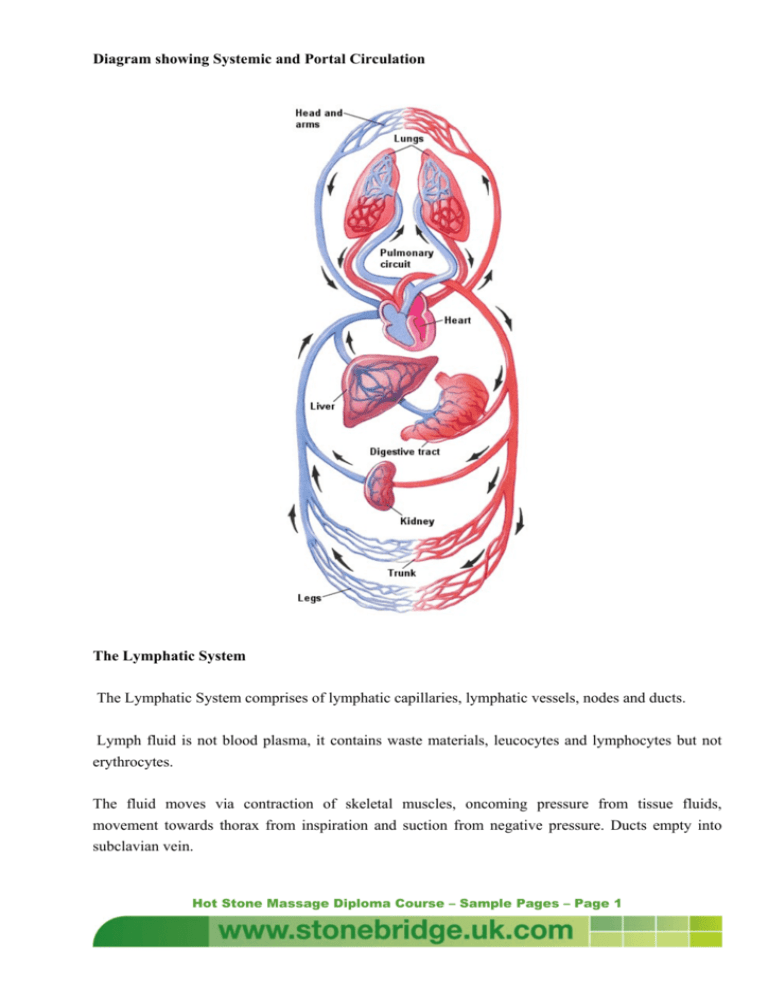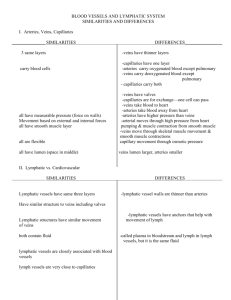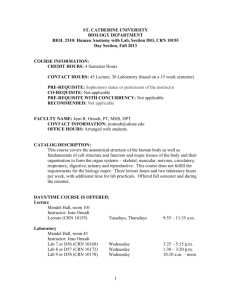Diagram showing Systemic and Portal Circulation The Lymphatic
advertisement

Diagram showing Systemic and Portal Circulation The Lymphatic System The Lymphatic System comprises of lymphatic capillaries, lymphatic vessels, nodes and ducts. Lymph fluid is not blood plasma, it contains waste materials, leucocytes and lymphocytes but not erythrocytes. The fluid moves via contraction of skeletal muscles, oncoming pressure from tissue fluids, movement towards thorax from inspiration and suction from negative pressure. Ducts empty into subclavian vein. Hot Stone Massage Diploma Course – Sample Pages – Page 1 The obstruction of lymphatic flow is known as oedema. Afferent vessels = arriving, Efferent vessels = exiting Lymph nodes made of lymph tissue: cells – phagocytes (engulf and destroy waste and bacteria). Lymphocytes (produce antibodies). Cells divide to form lymphocytes. Lymphatic nodes are named submandibular, posterior, auricular, anterior auricular, occipital, deep and superficial cervical, axillery, supratrochlear, inguinal, popliteal and found throughout the body. Lymph tissue areas are the tonsils, thymus, peyer’s patches(wall of small intestine),appendix, spleen(forms lymphocytes, kills erythrocytes and thromocytes, fights infection, stores blood). The Right Lymphatic duct drains lymph from right side, head, chest, neck, and arm. The Thoracic duct collects and drains lymph from left side – head, neck, trunk, arm and lower limbs. Disorders Hodkins’s disease and oedema. Summary Provides a channel for transporting excess tissue fluid away from tissues and back to the blood circulation. Collects and transports lymph from tissue walls. Nodes filter lymph of harmful materials before returning it to the blood circulation. Produces new lymphocytes. Produces antibodies. Lymphatic capillaries in lining of small intestine assist in the absorption of fat droplets. Hot Stone Massage Diploma Course – Sample Pages – Page 2 Effects of massage upon the Lymphatic System Massage is very useful in supporting the Lymphatic system as it assists with the movement of lymph fluid around the body. It helps reduce swelling (oedema) caused by too much fluid in the cells; it can help reduce cellulite and general body toxin overload. Diagram showing the Lymphatic circuit Hot Stone Massage Diploma Course – Sample Pages – Page 3 Diagram showing the Lymphatic Sites in the body The Muscular System This system consists of muscles of the body and their attachments – tendons and fascia. A muscle is a group of specialised elastic tissues. Muscle tissue is bundled together in a sheath (fascia) – the end of which attaches the muscle to other parts of the body via a tendon. Muscle is made up of 75% water, 20% proteins, 5%fats, mineral salts and glycogen. The Function of a muscle is to contract and start a movement in surrounding structures (tendons, ligaments and bones). Hot Stone Massage Diploma Course – Sample Pages – Page 4 Muscle contracts in reaction to a nerve stimulus sent by the brain through a motor nerve. The muscle then shortens becoming fatter at the centre. Other functions are to: Contract and produce movement, Stabilise joints, Maintain postural tone and aids in temperature control e.g.: shivering, dilation of capillaries. There are 3 types of muscle tissue. Voluntary/skeletal/striated – muscles we consciously control – arms/legs(look stripy). Involuntary/Smooth muscle – non-conscious use – walls of blood and lymphatic vessels, in respiratory, digestive and genito-urinary systems. Cardiac - to power pump action of heart – only found in heart. How do muscles work? 2 types of muscle contraction. Isometric – muscle contracts but produces no movement. Isotonic – muscle contracts and moves and the tension remains unaltered in the muscle. Muscles usually work in pairs – antagonist(opposing relaxing muscle) and agonist(contracting muscle) – both must contract and relax equally to ensure a smooth and not jerky movement. When to contract? Stimulus to contract comes from nervous system through nerves. Motor nerves enter muscles. Muscle gets energy from adequate blood supply which comes from oxygen and nutrients from arterial capillaries which is converted into energy by chemical changes. Used by muscles and lactic acid (waste product) excreted into venous blood stream. Hot Stone Massage Diploma Course – Sample Pages – Page 5









